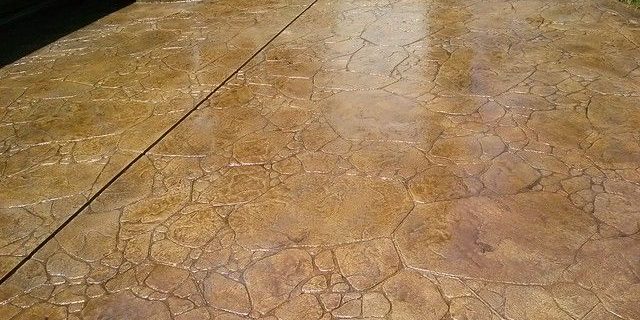
These are some reasons that we do not install stamped concrete at Tussey Landscaping. We use pavers instead. To get more information about our process, click here.
Stamped concrete is a poured concrete slab that is imprinted with a design or texture to replicate the look of pavers, natural stone, or another substance. Stamped concrete is often colored or dyed as an added feature.
Stamped concrete is a cheaper alternative to pavers, yet holds more aesthetic appeal than regular concrete. However, stamped concrete has a few drawbacks.
Here are five issues that we believe you should be consider before choosing stamped concrete for your project.
1. Stamped concrete tends to crack over time.
This isn’t unique to stamped concrete – any poured concrete will crack and move over time when exposed to freezing and thawing cycles.
2. Stamped concrete can be slippery, especially when wet.
This is usually a result of the surface finish done to the stamped concrete.
3. It can be challenging to get accurate coloring on a colored patio.
Some concrete patios are poured with regular concrete, then afterward sprayed with a sealer/color agent that gives the desired color. This spray-on sealer tends to peel off over time. Most spray-colored patios require resealing every few years, which is an added expense. For this reason, most concretes have a dye mixed in to give color through the concrete. At the concrete plant, the batch is mixed with the dye added, then loaded into trucks and hauled to the job site. Unfortunately, this dyeing process is not a specific procedure. Often even after a customer picks out the color they like, when the trucks of already mixed concrete arrive, it may be slightly different than expected. This color variation is commonly considered the responsibility of the customer. Since the pre-mixed concrete on the truck cannot be reused, the only way to change colors may be to pay to return the delivered concrete and purchase a new batch. This can quickly add cost to the project and stress on you.
4. Stamped concrete is difficult to repair or change.
After a concrete pad is poured and has cured (dried) in place, it is permanent. You cannot fix surface imperfections, chipped corners or edges, or puddling issues. The only way to remedy these problems is to cut out a patch of concrete and replace it or demolish and redo the entire project.
5. Salt cannot be used to remove ice from stamped concrete.
The chemical compound in salt will cause the surface of the concrete to chip and fracture off if exposed to concrete. This makes snow and ice removal difficult, especially with a textured surface that makes shoveling difficult.
Contact Us
If you’re looking to build or re-do your patio or pool area, let us know how we can help. We’re happy to answer questions you might have or to provide an estimate. Call us at 814-696-3700 or contact us online.
